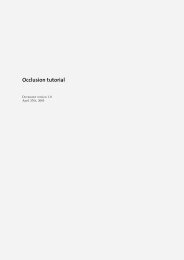mental ray Architectural and Design Visualization Shader Library
mental ray Architectural and Design Visualization Shader Library
mental ray Architectural and Design Visualization Shader Library
Create successful ePaper yourself
Turn your PDF publications into a flip-book with our unique Google optimized e-Paper software.
2.5 Detailed Description of Material Parameters 23The refl hl only mode takes no additional render time compared to a non-glossy (diffuse)surface, yet can yield surprisingly convincing results. While it may not be completelyconvincing for “hero” objects in a scene it can work very well for less essential scene elements. Ittends to work best on materials with weak reflections or extremely glossy (blurred) reflections:The left two cups use real reflections, those on the right use refl hl onlyWhile the two cups on the left are undoubtedly more convincing than those on the right, thefact that the right h<strong>and</strong> cups have no additional render time compared to a completely nonreflectivesurface makes this mode very interesting. The emulated reflections still pull in adirectional color bleed such that the bottom side of the cup is influenced by the color of thewooden floor just as if it was truly reflective.2.5.3 RefractionsThe transparency parameter defines the level of refractions <strong>and</strong> refr color defines the color.While this color can be used to create “colored glass”, there is a slightly more accurate methodto do this described on page 49.Due to the materials energy conserving nature (see page 8) the value set in the transparencyparameter is the maximum value - the actual value depends on the reflectivity as well as theBRDF curve.The refr ior defines the Index of Refraction, which is a measurement of how much a <strong>ray</strong>of light “bends” when entering a material. Which direction light bends depends on if it isentering or exiting the object. The mia material use the direction of the surface normal asthe primary cue for figuring out whether it is entering or exiting. It is therefore important tomodel transparent refractive objects with the surface normal pointing in the proper direction.The IOR can also be used to define the BRDF curve, which is what happens in the class oftransparent materials known as “dielectric” materials, <strong>and</strong> is illustrated here:
















